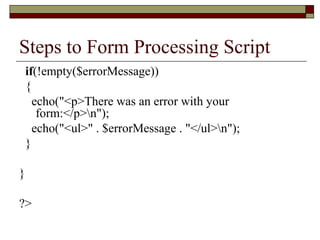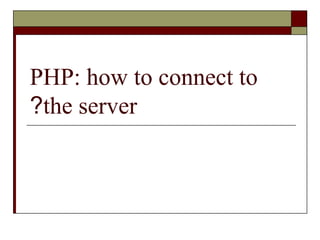Web forms and server side scripting
- 1. Web forms and Server Side Scripting Sawsan Slii Marzouki Internet Applicatiosn Development
- 3. What is a server? Many types of server: File server FTP server Web server Mail server News server
- 4. Dynamic Interactive Web Server (3-tier architecture(
- 6. Web content HTML documents are static Dynamic content : User side programming (JavaScript, CSS, Ajax, JQuery……) Server side programming (PHP, ASP and ASP.Net, JSP, Python….)
- 7. Why Server Side Programming? Accessibility : Any one can reach Internet. Manageability : Does not require distribution of application code Security : Source code is not exposed Scalability : ()تطور Web-based 3-tier architecture can scale out
- 8. History of web dynamic content Common Gateway Interface (CGI) was the first generation approach to providing dynamic web content (used scripts) Numerous second generation alternatives were invented (FastCGI, mod_Perl, NSAPI, ISAPI, Java Servlets…) Scripting, the third generation approach
- 9. Scripting, the third generation approach Embed simple code in HTML pages The HTML pages use the code to decide what elements to display and what data should be displayed. Classes and/or subroutines can be called to compute information for inclusion in the web page. This is know as « scripting ».
- 10. Scripting languages or compiled Scripting languages Compiled languages Server Side Includes (SSI) Perl PHP ASP (VBScript) Python C C++ ASP.Net Java Servlet Java Server Pages
- 11. Some approaches to Scripting JavaServer Pages (JSP) by Sun MicroSystems Hypertext Preprocessor (PHP): open source Cold Fusion (CFML) by Macromedia Active Server Pages (ASP and ASP.Net) by MicroSoft
- 12. Criteria affecting Scripting choice Web Server availability Knowledge of language Scalability and efficiency Personal preference
- 13. Learn more about JSP, PHP and ASP.Net
- 14. JSP (Java Server Pages( Java-based technology that simplifies the development of dynamic websites Designed around the Java Philosophy Packaged with J2EE It separates presentation aspects from programming logic contained in the code.
- 15. J2EE Technology Web container (application server) EJB container Servlets : JSP pages running in webServers JSP: JavaServer Pages Apples, XML, JDBC, …….
- 16. Servlets and JSP
- 17. JSP Basics Individual JSP pages are text files stored on the web server. When a page is first required, then JSP Engine uses the page to generate a Servlet. The compiled Servlet is saved and used to serve additional requests. When a page is modified, the appropriate Servlet is regenerated. Precompilation is also possible
- 18. A simple JSP code New.java.util.Date().ToString(): creates a date Object and converts it to a String that can be displayed
- 19. What is PHP? Open source Server-Side Scripting language designed specifically for the web. Conceived in 1994. Supports a wide-range of databases. Perl and C like syntax. Designed similar to ASP: you embed commands into your web pages.
- 20. What is PHP? Commands are preprocessed by Php processor and appropriate HTML is sent to the web server. Platoform independant Easy to learn Usually associated to MySQL database (a relational free DBMS, can run on Unix, Windows, and Mac OS).
- 21. Php Process Flow
- 23. ASP.Net Based on .Net Framework and the common language runtime (CLR) Compiled language MicroSoft Only Platforms
- 24. web forms and Server Side Scripting
- 26. Steps to Form Processing Script Creating the HTML code for the form <form action="myform.php" method="post"> <!-- form fields here --> </form> The “action” specifies what page to submit the form to. The “method” indicates how the form is submitted :Get and Post. Most of the time, forms will use the “post” method.
- 27. Steps to Form Processing Script <form action="myform.php" method="post"> Which is your favorite movie? <input type="text" name="formMovie" maxlength="50"> <input type="submit" name="formSubmit" value="Submit"> </form>
- 28. Steps to Form Processing Script Getting the form data: The input of type “text” is just a single line field to type in some text. We give it a name of “formMovie” . You have a button submit that submits the whole form once clicked on.
- 29. Steps to Form Processing Script <?php if($_POST['formSubmit'] == "Submit") { $varMovie = $_POST['formMovie']; } ?> <form action="myform.php" method="post"> Which is your favorite movie? <input type="text" name="formMovie" maxlength="50"> <input type="submit" name="formSubmit" value="Submit"> </form>
- 30. Steps to Form Processing Script Validating the input: Suppose we have a user who forgot to enter one of the fields? We need to validate the form to make sure it’s complete and filled out with valid information.
- 31. Steps to Form Processing Script <?php if($_POST['formSubmit'] == "Submit") { $errorMessage = ""; if(empty($_POST['formMovie'])) { $errorMessage .= "<li>You forgot to enter a movie!</li>"; }
- 32. Steps to Form Processing Script if(empty($_POST['formName'])) { $errorMessage .= "<li>You forgot to enter a name!</li>"; } $varMovie = $_POST['formMovie']; $varName = $_POST['formName'];
- 33. Steps to Form Processing Script if(!empty($errorMessage)) { echo("<p>There was an error with your form:</p>n"); echo("<ul>" . $errorMessage . "</ul>n"); } } ?>
- 34. PHP: how to connect to the server?
- 35. PHP: How to connect to the server? Option 1: Website on a hosted server Option 2: Install PHP on your computer Option 3: XAMPP
- 36. Website on a hosted server Create a file in Notepad (or similar text editor) named test.php Insert the following code in the file: <?php echo "Hello World!"; ?> Upload the file to your web host. Open the file in your browser. If the browser writes "Hello World!" your web host supports PHP and you are ready to go. Otherwise contact your hosting provider for more information.
- 37. Install PHP on your computer We will learn more about this option in practice using EasyPhp.
- 38. XAMPP Open the program XAMPP Control Panel Start the Apache server and the MySql server: Create a file in Notepad named test.php . Insert the following code in the file: <?php echo "Hello World!"; ?> Save the file in the folder "c:xampphtdocs". Open the file in your browser with the address http://localhost/test.php. If the browser writes "Hello World!" the installation is successful, and you're ready to run PHP on your computer.

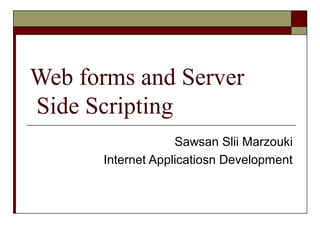
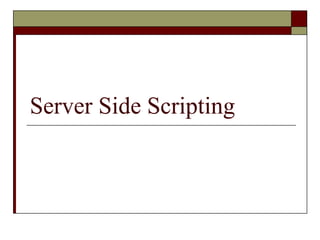
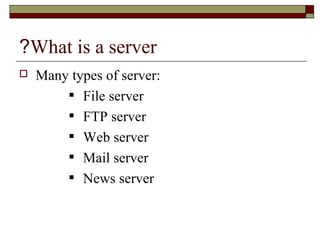
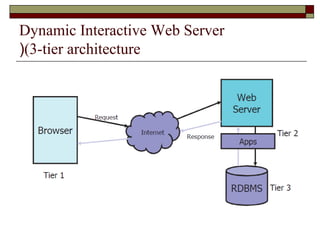

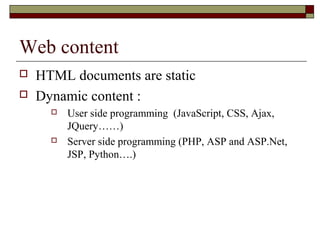





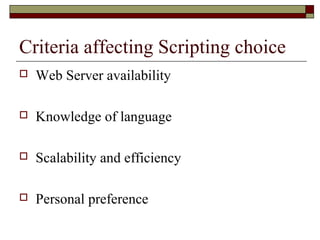
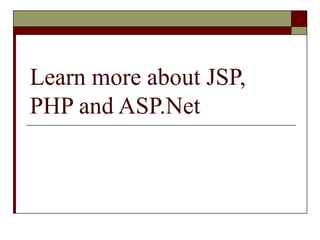


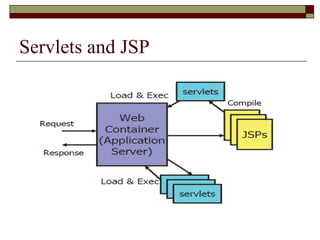
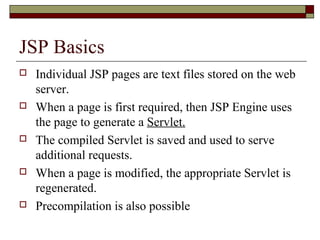
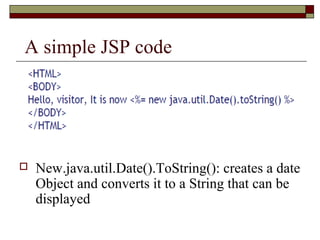
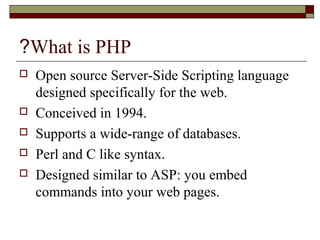
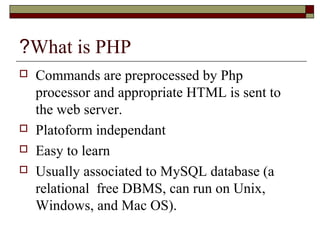



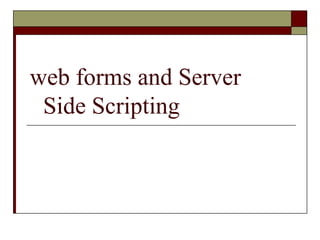

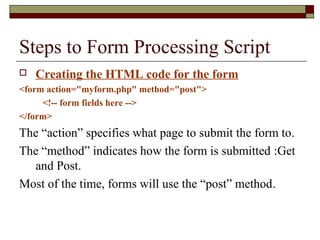


![Steps to Form Processing Script
<?php
if($_POST['formSubmit'] == "Submit")
{
$varMovie = $_POST['formMovie']; }
?>
<form action="myform.php" method="post">
Which is your favorite movie?
<input type="text" name="formMovie" maxlength="50">
<input type="submit" name="formSubmit" value="Submit">
</form>](https://image.slidesharecdn.com/webformsandssscripting-150305035707-conversion-gate01/85/Web-forms-and-server-side-scripting-29-320.jpg)

![Steps to Form Processing Script
<?php
if($_POST['formSubmit'] == "Submit")
{
$errorMessage = "";
if(empty($_POST['formMovie']))
{
$errorMessage .= "<li>You forgot to enter a movie!</li>";
}](https://image.slidesharecdn.com/webformsandssscripting-150305035707-conversion-gate01/85/Web-forms-and-server-side-scripting-31-320.jpg)
![Steps to Form Processing Script
if(empty($_POST['formName']))
{
$errorMessage .= "<li>You forgot to enter a
name!</li>";
}
$varMovie = $_POST['formMovie'];
$varName = $_POST['formName'];](https://image.slidesharecdn.com/webformsandssscripting-150305035707-conversion-gate01/85/Web-forms-and-server-side-scripting-32-320.jpg)
